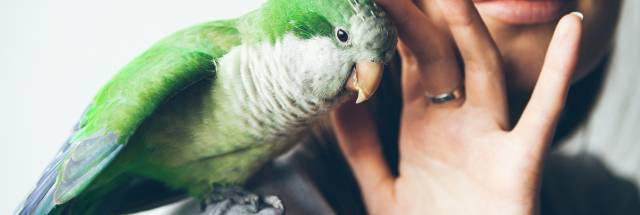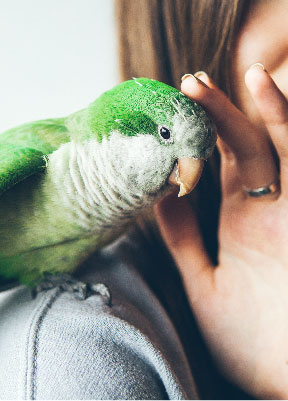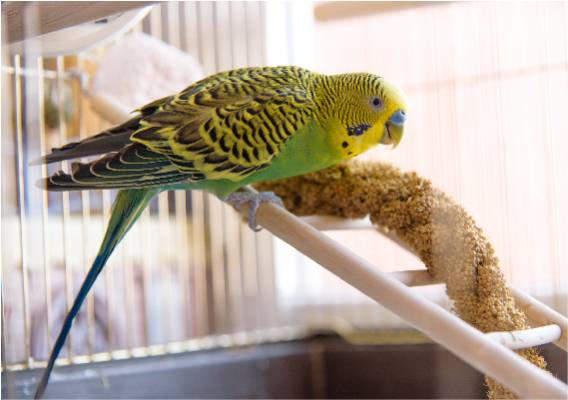
What do domestic birds eat?
HOW TO FEED DOMESTIC BIRDS PROPERLY: 5 GOOD HABITS TO ADOPT
You are keen to have some domestic birds in your home to enjoy their birdsong and the touch of joy they bring. Excellent idea, but what do domestic birds eat? These birds have specific needs. They are demanding and clearly display their preferences. Find out how to feed your domestic birds properly, to keep them happy and healthy.
1. UNDERSTAND THAT EACH TYPE OF DOMESTIC BIRD HAS A SPECIFIC DIET
What do birds eat? There are as many answers to this question as there are bird species.
The shape of the bird’s beak largely determines their diet and, therefore, their needs:
- most domestic birds are granivores (or seed eaters), such as canaries. They have a straight, cone-shaped beak that is strong enough to peck the seeds which form their daily diet;
- thin-beaked birds correspond more to those found in your garden in winter, and are insectivores (or insect eaters), such as robins and blackbirds. They are thus fond of worms and all kinds of insects, readily available in nature in warm weather;
- birds with more powerful hooked beaks, such as parrots and parakeets, are frugivores (or fruit eaters). They are able to pick up fruits, but can also break up seeds. They are fond of food, and particularly enjoy fresh food;
- more exotic, nectarivorous birds, such as hummingbirds, feed on flower pollen and nectar. Their beak is adapted to the shape of the flower from which they feed. This category includes lories and lorikeets; however, they are difficult to feed in captivity and can develop health problems if fed an unsuitable diet. We advise against having a nectarivorous bird if this is your first experience with birds.
What shape is your bird’s beak? If you are planning to keep birds in your home, you will have no problem feeding granivorous or frugivorous birds!
2. PROVIDE A FEED DISPENSER SYSTEM SUITED TO EACH TYPE OF DOMESTIC BIRD
If each type of beak has its own diet, then each species has its own preferential type of feed dispenser.
This means that if you keep very different types of birds, then you will need to provide feeders, rations, diets and feed dispensers to match the number of species!
However, two main categories of granivores can be identified:
- granivorous domestic birds who like to feed at a specific time once or twice a day;
- granivorous domestic birds who prefer to have a constant food supply, due to having a faster metabolism.
🐦 Pay attention to quantities! If you opt for ad lib feeding, note that some seeds are very rich and can overload your bird’s liver or cause it to become overweight. Domestic birds are much less physically active than wild birds, so their diet should be adapted accordingly.
3. LEARN ABOUT THE VITAMIN AND MINERAL REQUIREMENTS OF DOMESTIC BIRDS
To help keep your granivorous domestic bird healthy, you need to learn about its requirements.
Seed and feed mixes specially designed for birds are rich in:

- protein, approximately 20% of daily requirements, source of essential amino acids, particularly vital during the moulting phase;
- fats and carbohydrates for proper metabolic function;
- minerals to support healthy bones and eggshell formation;
- trace elements, particularly iodine, but also cobalt, copper, iron, manganese and zinc;
- vitamins simply to remain in good health and have better resistance to diseases. The main vitamins that birds need are: vitamin A, vitamin D3 essential to calcium binding, vitamin E and B vitamins, especially B12.
Domestic birds need a balanced, varied diet in order to have access to the nutrients vital to their metabolic function and to optimise their resistance to diseases.
🦴 And calcium? Calcium is one of the essential minerals for domestic bird health. It supports good skeletal development, bone health and eggshell formation. However, deficiencies are common. These can cause a soft beak, locomotion problems, bone malformations, egg binding, etc. You can place cuttlebone or gravel in the bottom of your bird cage. These contain calcium which will also aid their digestion.
To make sure all these nutrients are present in your bird’s feeder, mixes mainly contain the following types of grain:
- sunflower;
- colza;
- linseed;
- maize;
- hempseed;
- carob;
- wheat;
- oat groats;
- rape;
- millet;
- etc.
As the grains have a low vitamin content, you need to offer your birds complementary foods to cover their metabolic requirements if these are not included in the mix.
Peanuts, walnuts and almonds are foods with a high fat content, to be fed sparingly or in periods with high energy requirements.
Your domestic birds will have everything they need with Hopi Family millet sprays and Premium menus.
🍌 Clear preferences: you might notice that your birds also have their special preferences when you clean their feeder. Some domestic birds therefore sort their food and leave any grain they find less appealing. This behaviour can lead to deficiencies. We advise against giving your birds only their favourite grain, so as to maintain a balanced diet. With time, they may change their minds and start pecking at grain which they had previously discarded.
4. USE FEEDING AS A WAY TO STIMULATE THE INSTINCTS OF GRANIVOROUS BIRDS
In the wild, birds are used to searching for their food. This is one of their main activities, along with flying! It is also an obligation in order for wild birds to survive. This is why wild birds should only be fed during extremely cold periods, when food is truly sparse. Otherwise, they will get used to not searching for their own food. They will become dependent on the food you put out for them, which will threaten their very survival.
Domestic birds do not face these types of problems, as you are there to feed them every day. However, this doesn’t mean we can’t encourage them to use their instincts to search for food.
You can stimulate this behaviour in your domestic birds by hiding food in the cage, such as small pieces of fruit or vegetables, or even their usual seeds. This playful activity will be beneficial to your bird, both in terms of its dietary intake but also its mental wellbeing. It won’t have time to get bored!
🕊️ What size cage does a bird need? Choosing the right cage for your domestic birds’ needs is as important as choosing the right diet. Birds living in cramped conditions will be unhappy. Length is an important criterion as birds fly horizontally: a cage 60 cm in length can be suitable for small birds, but you should preferably choose a cage 100 cm in length for medium-sized birds.
Aside from the size, the cage should be easy to clean and, above all, it should not pose any danger to your birds. The spacing between the bars should be sufficiently narrow to prevent birds squeezing their head between two bars. Also pay attention to the door closure system as some birds soon figure out how they work and manage to open them as soon as your back is turned.
5. PROVIDE YOUR DOMESTIC BIRDS WITH A GRAIN RATION SUITED TO THEIR REQUIREMENTS
Domestic birds need a healthy, balanced diet in every season and at every stage of their lives. Certain stages of a bird’s life call for more specific requirements:
- breeding periods, varying in duration, with the pre-mating period at the end of winter and the post-mating period at the end of summer. Laying occurs once a year at different times depending on the type of domestic bird;
- fledging development;
- moulting with feather regrowth.
Depending on their requirements, you can supplement your birds’ diet via its food or drinking water: pastes, biscuits, condition seeds, etc.
As a general rule, a bird consumes 15 to 30% of its body weight per day, more in winter than summer.
For your birds’ wellbeing, make sure you remove any uneaten seeds daily, to avoid them rotting at the bottom of the cage.

🍬 What type of treats can domestic birds have? Domestic birds also love treats. You will enjoy finding out which treats your birds love the most. As a general rule, birds are very partial to small pieces of fruit, grated vegetables and insects. Parrots adore fresh food. Preferably feed in the morning so as to remove any leftovers during the day, to prevent mould growth.
A canary weighs 15 grams on average and eats 30% of its body weight daily, i.e. 5 grams. This is equivalent to approximately 16 kcal. On such a small scale, the slightest digestive problem could be fatal to your bird. Take care to provide quality feed, perfectly suited to your birds’ needs, to make sure they have a long happy life with you.

